The Ultimate Durham Spring Guide
Are you so excited for spring that you wet your plants? Here’s our ultimate seasonal guide for spring – blooming with experiences and... Read More
Here's everything you need to know to navigate one of the most beautiful botanical gardens in the U.S.
Nestled in the heart of Durham lies Duke Gardens, a 55-acre botanical wonderland where the hum of cars and traffic disappear, birds serenade visitors from treetops and streams flow alongside pathways connecting people to more than 2,500 colorful plant species. Over 600,000 people visit Sarah P. Duke Gardens every year to experience an artful expression inspired by nature and to enjoy hours of discovery, exploration and inspiration.
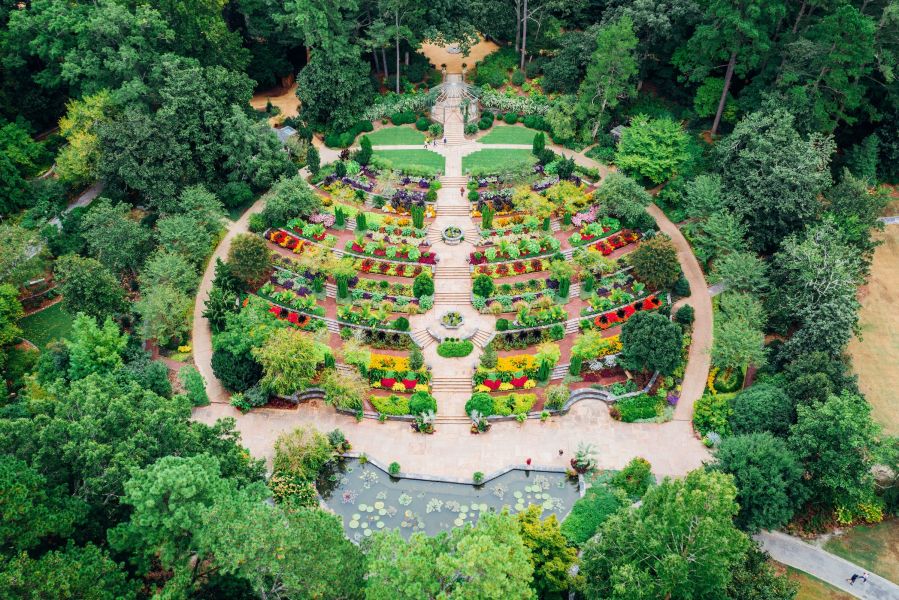
The terraced gardens at Duke Gardens look just as beautiful from above as they do from the ground. Photo: Estlin Haiss
Sarah P. Duke Gardens is about to undergo some changes that will be transformative to the already amazing visitor experience. Fortunately, the garden will remain open, with a few small changes, while these renovations are made. As one of the first steps, a new, pedestrian only main entrance on Lewis Street will open while the Anderson Street entrance will close. The entrances accessible from within Duke's campus will remain open.
While weekday parking will not be available during renovations, weekend visitors can still pay to park at the H lot on Anderson Street. To visit the gardens during the week, use alternate transportation – rideshare, bus or bicycle. Bus options are outlined on the gardens' website.
Beyond the entrance changes, the Garden Gateway Project will eventually provide guests with a new welcome center with a café, gallery, upgraded restrooms and an outdoor event space. The Doris Duke Center will also see significant renovations. By spring 2026, the project will be completed, offering a new, more accessible entrance, more green spaces, new facilities and renovated spaces.

By the Spring of 2026, the Duke Gardens welcome center will have a whole new look. Photo: Sarah P. Duke Gardens
Location: 420 Anderson St. Durham, NC 27705
On the West Campus of Duke University (adjacent to the iconic Duke Chapel and the campus’ surrounding neo-Gothic architecture)
A new, temporary entrance is located on Lewis Street during renovations. Lewis Street is pedestrian only. No car access is available at the gate. Bicycle parking is provided.
Hours: Duke Gardens is open daily from 8 a.m. to dusk
Admission: Free
Bathrooms: There are temporary bathrooms available at the Lewis St. entrance. There are also bathrooms in the Terrace Gardens and the Asiatic Arboretum, which remain open later in the day.
Parking: During the Garden Gateway Project, which will be in progress Feb. 3, 2025 - Spring 2026, weekday visitors are encourage to take alternate transportation because parking will be unavailable.
On weekends, pay parking will be available at the H Lot on Anderson Street between Lewis St. and Yearby Ave. Parking is also often available in the lot at 536 Anderson St., near the corner of Campus Dr.
To pay for parking, you can use the Pay By Phone app and enter location 3109. WiFi is often weak in the parking lots, so it's best to download the app and create your account before heading to the Gardens to speed up your parking purchase.
Food: The Terrace Café is located in the Bartter Family Terrace House. The menu varies but usually includes a variety of salads, sides, sandwiches, cold beverages, coffee, snacks, ice cream and gluten-free options. The café closes each year in mid-November for the winter season and typically reopens in late March.
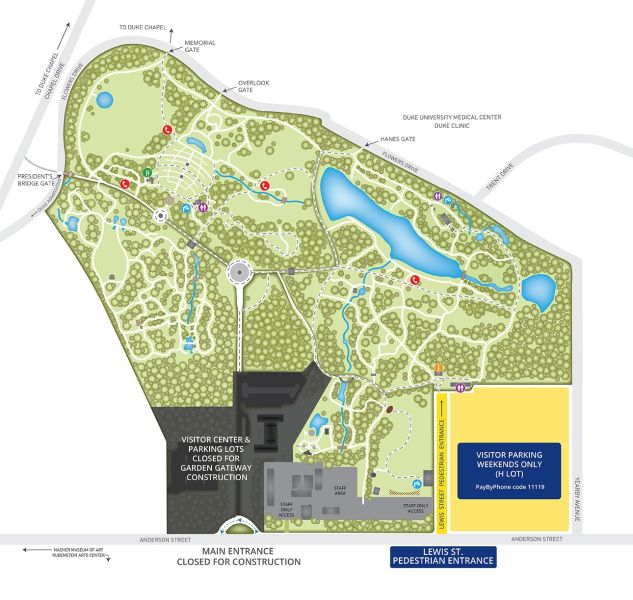
Use this map to find the new entrance to Duke Gardens and locate the areas that will be closed. Photo: Sarah P. Duke Gardens
Start your adventure at the kiosk by the Lewis Street entrance, where you can pick up a map and visitor guide to assist you in your walk through the various gardens.
The color-coded map highlights the Historic Gardens, the H.L. Blomquist Garden of Native Plants, the W.L. Culberson Asiatic Arboretum, and the Doris Duke Center & Gardens — the four main areas of Sarah P. Duke Gardens. All of these stunning areas have diverse and colorful flowers and plants for you to explore.
From the Lewis Street entrance, your closest destinations in the garden are the Doris Duke Center Gardens, to the left, and the W.L. Culberson Asiatic Arboretum, forward and to the right.
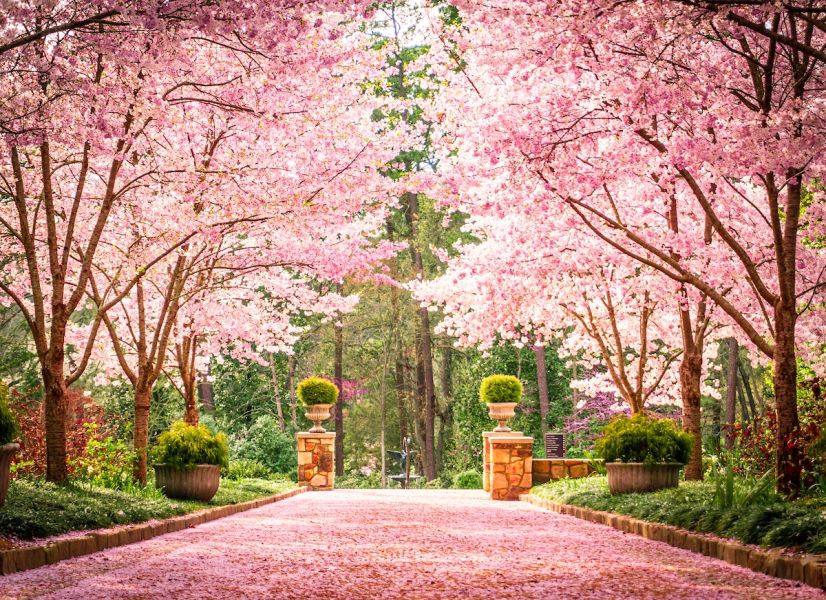
Make sure you stroll through Cherry Allée, which bursts into bloom in March. Photo: Discover Durham
Named for Duke Professor and former Duke Gardens Director William Louis Culberson, the Asiatic Arboretum is an 18-acre collection of plants representing the wealth of floral diversity in Southeast Asia.
As you explore the Arboretum trails, you'll find many garden favorites — Japanese maples, irises, peonies, ginger lilies and cherries — as well as a host of less familiar but equally interesting and ornamental species. Hidden in this area, you will also find one of the nicest Japanese-style bathrooms. (You should check it out even if you don't need to use the bathroom!) Stop by the Pine Clouds Mountain Stream, a dramatic new Japanese Garden, featuring a recirculating stream and waterfalls, and make sure to walk across the Meyer Bridge, a popular arched bright red bridge surrounded by bamboo.
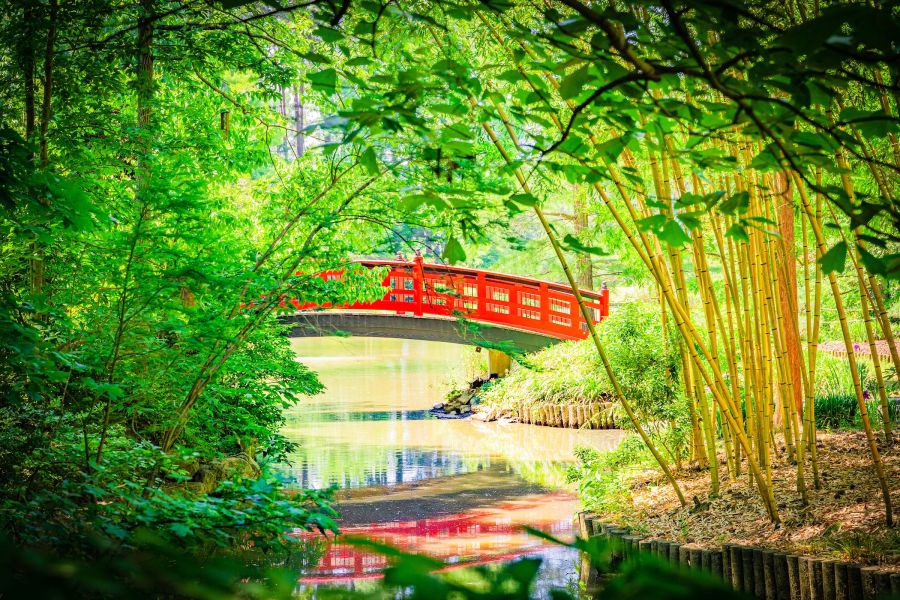
You won't want to miss the iconic red arched bridge in the Asiatic Arboretum. Photo: Discover Durham
Head directly to the left from the Lewis Street entrance and prepare to get lost in botanical wonders. The Virtue Peace Pond features an extensive collection of hardy and tropical water lilies, lotuses and marginal water plants. Inspired by England’s many white-flowered cottage gardens, the Page-Rollins White Garden adjoins the Angle Amphitheater, the setting for many weddings and special events.
Stroll through the Woodland Garden to the Charlotte Brody Discovery Garden, where you can learn about organic vegetable and fruit gardening as well as water management through rain gardens. Children will enjoy sitting on tree stumps in the story circle and watching the chickens. Check the garden’s events page to see programs and resources for adults, children and families.
As you reach the end of theses gardens, you'll eventually come up on the back entrance of the Doris Duke Center, which will be closed until renovations end in the Spring of 2026.
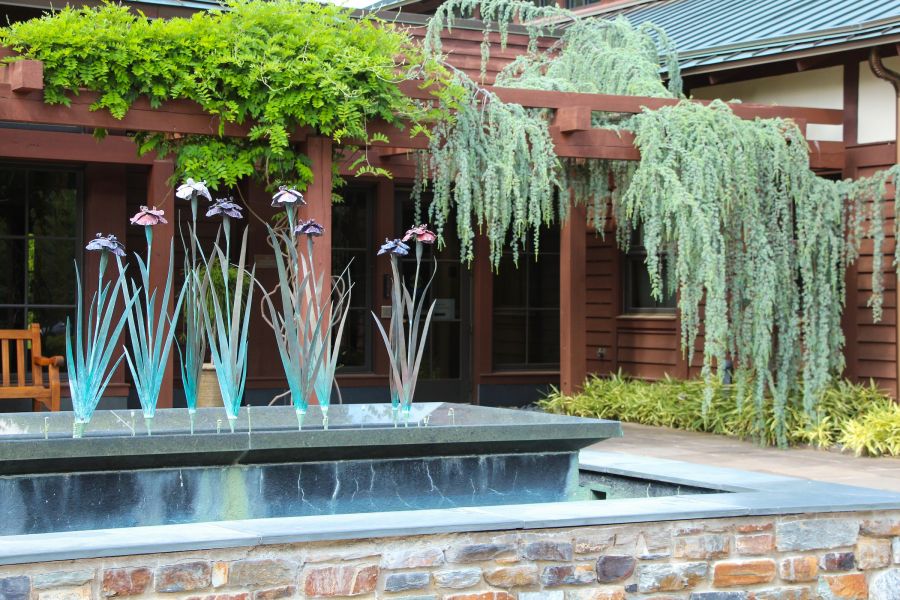
The entrance to the Doris Duke Center at Duke Gardens is closed until Spring 2026. Photo: Discover Durham
Walking along the path from the Doris Duke Gardens will eventually take you to the Historic Gardens The pathway leads down to the Rose Garden, which features heirloom roses, ornamental grasses, palms, perennials and succulents. In the center of the garden, you can't miss the iconic Roney Fountain, a stunning garden centerpiece over a century old that was recently painted an exquisite deep green.
Continue walking southwest down the perennial allée to see the famous Terrace Gardens and relax under a more than 80-year-old pergola. The Terrace Gardens’ beds are filled each season with combinations of bulbs, annuals, perennials, ornamental grasses, potted plants and scree gardens. In the summer, the fish pool is filled with hardy and tropical water lilies, and the koi fish are always popular with visitors. Bring lunch and picnic in one of the wide-open green spaces in the Historic Gardens.
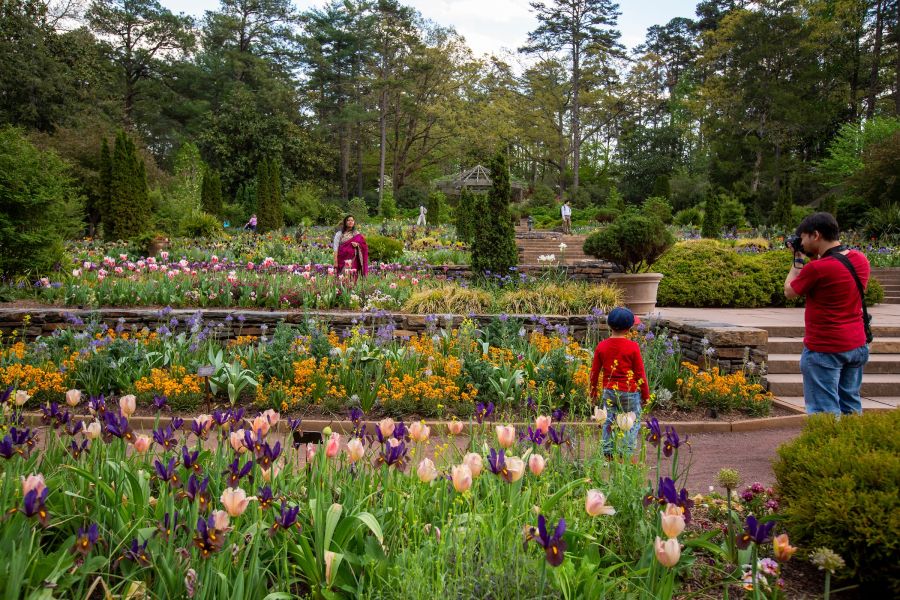
Pause for a photo op at the Terraced Garden. Photo: Jared Lazarus
The 6.5-acre H.L. Blomquist Garden of Native Plants is filled with more than 900 species and varieties of regional native plants. Many of them found a home in this garden after approved plant-rescue operations from land-facing development. Dedicated in 1968, the garden honors Professor Hugo L. Blomquist, the first chair of Duke University’s Department of Botany and an authority on Southeastern flora.
Relax quietly by the bird viewing shelter to see a host of bird species attracted to the nearby feeding station. Walk down the new boardwalk, check out the Piedmont Prairie and learn about rare and endangered plants at the Steve Church Endangered Species Garden.
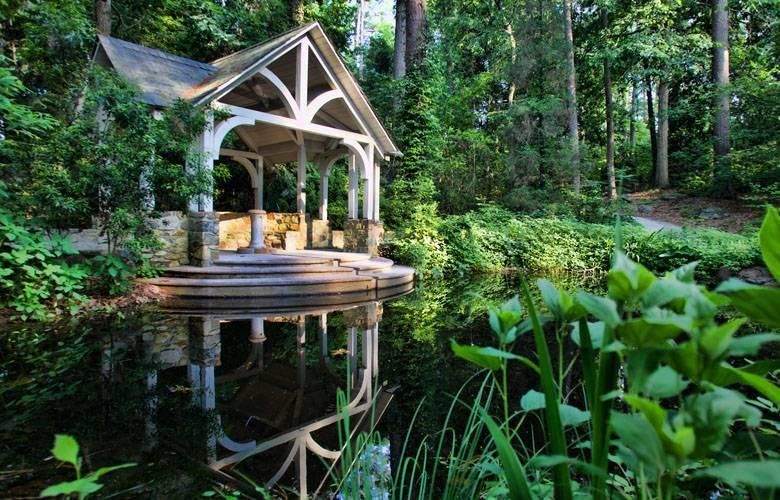
Blomquist Pavilion in the Garden of Native Plants at Duke Gardens. Photo: Discover Durham
You probably won’t be able to visit every extraordinary attraction Sarah P. Duke Gardens offers in one day, and that’s okay. Seasonal plantings ensure that each visit is an entirely new experience, so go ahead a plan another trip!
The Ultimate Durham Spring Guide
Are you so excited for spring that you wet your plants? Here’s our ultimate seasonal guide for spring – blooming with experiences and... Read More
The Outdoor Adventure Guide to Durham
Opportunities to enjoy the outdoors are around every corner in Durham. Leave the planning to us and follow our outdoor adventure itinerary,... Read More
Durham’s Best Date Ideas Got us Fallin’ in Love
Roses are red. Violets are blue. Discover these romantic spots in Durham for you and your boo. Read More